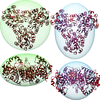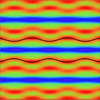issue contents
April 2019 issue

Cover illustration: Reducing the background of ultra-low-temperature X-ray diffraction data through new methods and advanced materials. Courtesy of McMonagle & Probert [J. Appl. Cryst. (2019), 52, 445–450].
research papers
Lamellar thin films are an important class of soft materials. For such systems, grazing-incidence scattering with an area detector close to the incident plane is simulated.
An estimation of the influence of X-ray diffraction pattern angular range on Rietveld refinement results used for quantitative analysis, crystallite size calculation and unit-cell parameter refinement is presented. After statistical treatment of the results obtained, it has been established that these differences are statistically insignificant.
Numerical modeling of lattice distortion and deformation in energy-optimized nanocrystallites is presented. The results indicate that the lattice strains in such particles have complex heterogeneous distributions which cannot be captured by simple diffraction analysis.
A direct approach to estimate the anisotropy of protein structures from small-angle X-ray scattering
In this work, a Guinier-like approximation to directly estimate the anisotropy of molecules in solution from their small-angle X-ray scattering intensity around the origin is developed. This approach provides deeper insight into a molecule's structure than the traditional Guinier RG estimation and can be used in ab initio reconstruction methods to provide better initialization strategies.
Open  access
access
 access
accessA free-film sample environment for neutron scattering, particularly useful for in situ small-angle neutron scattering, is presented, providing a sample area of up to 7 × 20 mm and an average thickness of 500 µm. The instrumental background is reduced by 37% compared with standard Hellma cells, and a helium jacketing of the entire setup provides a minimized H/D exchange with the humidity from air.
A new method of calculating interatomic spacing has been proposed. The new method does not require any auxiliary illustration.
An unexpected ring in the scattering pattern of highly oriented pyrolytic graphite (HOPG) was observed, which arises from the unique structural and dynamic features of HOPG. A possible interpretation by multiple scattering including elastic and inelastic processes is proposed.
The crystal structure of a novel phase of lead dioxide, γ-PbO2, forming nanosheets, is identified by energy dispersive spectroscopy microanalysis, transmission electron microscopy and electron microdiffraction. On the basis of the symmetry analysis, the hexagonal-prismatic shape is explained and a mechanism of formation is proposed.
Stoichiometric antimony selenide (Sb2Se3) nanocrystals have been successfully engineered by a facile physical vapor deposition method, employing a single precursor of polycrystalline Sb2Se3 charge in a closed quartz ampoule under high vacuum without any foreign seed or extraneous chemical elements.
Grazing-incidence small-angle X-ray scattering (GISAXS) is used to examine crystalline and locally quasicrystalline 2D photonic structures produced by nanoimprint lithography for photovoltaic applications. Using a hierarchical theoretical description, lattice distortions are quantified from the GISAXS measurements, showing the differences in reproduction quality between the investigated samples.
The evolution of residual stress and its correlation with microstructure are investigated systematically in nano-scaled periodic W/B4C multilayers as a function of individual layer thicknesses at the ultra-thin limit (∼0.4–3 nm). It is observed that the physical properties of the materials, their interfacial morphology and the residual stress in the film undergo significant modification as the layer thickness varies from the continuous to the quasi-discontinuous regime, and this behavior is explained using a model of the mechanism of film growth.
A gold nanoparticle suspension is established as an absolute intensity standard for small-angle X-ray scattering experiments on dilute liquid suspensions. An extension of the Guinier method was used to achieve maximum precision on the extrapolated intercept at Q = 0.
Characterization of Bragg-edge transmission imaging on the new IMAT beamline at the ISIS pulsed neutron source is performed and application of the technique is demonstrated. Bragg-edge transmission is capable of producing accurate strain maps with high spatial resolution and spatially resolved texture information, non-destructively.
Open  access
access
 access
accessA small-angle scattering model for wood is presented and its capabilities for studying the nanoscale structure and moisture behaviour of wood are demonstrated.
Open  access
access
 access
accessA setup is constructed to facilitate difference X-ray scattering studies at a synchrotron-based protein crystallography beamline. This setup provides a flexible platform for preparative studies of protein structural dynamics.
Using a simple model, the modification of the contrast in the form factor dependence on q orientation by elastic deformations is studied.
The development of the Martini bead form factors for nucleic acids is presented, together with their implementation in the PLUMED library. In combination with the form factors for proteins, they allow accurate and efficient structure refinement of proteins and nucleic acids against small-angle X-ray scattering (SAXS) data.
Open  access
access
 access
accessA global small-angle scattering model for unoriented, fully hydrated, inverted hexagonal phases is provided. The model is evaluated using Bayesian probability theory to obtain reliable estimates for the structural parameters.
Dislocation densities of Zircaloy-2 tensile samples are measured using two diffraction-based techniques. The relative sensitivities of the techniques to dislocations produced during cold work are compared.
Open  access
access
 access
accessA general indexing procedure for grazing-incidence X-ray diffraction patterns recorded from fibre-textured films is introduced for lattices of monoclinic and higher-symmetry systems. The analytical mathematical expressions are given and their use is demonstrated in detail for two cases (monoclinic and orthorhombic).
An electron density model for small-angle X-ray scattering from a novel thickness-modulated phase of lipid membranes is presented, and analytical expressions are derived for the intensities of the diffraction peaks. Structural parameters of the membranes in this phase have been determined from a least-squares fit of the calculated intensities to the observed ones.
Download citation


Download citation


Open  access
access
 access
accessNew methods to reduce the background when using a closed-cycle helium refrigerator for collecting single-crystal X-ray diffraction data at ultra-low temperatures are presented.
teaching and education
Free 

The incorrect yet widespread use of terms `lattice', with or without the modifiers `super' and `sub', and `low-dimensional structure' is pointed out, and simple guidelines for a correct use are given.
Free 

Microdisplays as a versatile tool for the optical simulation of crystal diffraction in the classroom
A demonstration is given of how to perform crystallographic diffraction experiments using low-cost easily accessible microdisplays. It is shown that, by optically transforming two-dimensional periodic greyscale structures, students can intuitively learn the basic concepts of applied crystallography such as reciprocal space, symmetry violations and structure factors.
short communications
This article presents the design, mechanical drawings and outline methodology for the construction and use of a single-crystal growth cell; its application to determine face-specific growth rates and mechanisms in seeded or unseeded experimental conditions is highlighted.
computer programs
This article describes the computer program StructureFinder, which collects unit cell, experiment and refinement information from single-crystal structure measurements in a database and provides a user-friendly interface for finding this information from previous measurements.
Aquarium is an automatic data processing and experiment information management system for synchrotron radiation source macromolecular crystallography beamlines. Aquarium is designed to automatically process data sets from data reduction to model building and results presentation. Users can monitor and inspect the data processing results from the Aquarium web site.
d2Dplot is a computer program for the visualization and processing of 2D X-ray diffraction data including a user-created compound database and a peak analysis routine for the application of the through-the-substrate microdiffraction methodology.
laboratory notes
An X-ray transparent electrochemical cell with dense glassy carbon windows (Sigradur-G) for operando bench-top X-ray diffraction in reflection geometry is demonstrated.
crystallographers
Free 

book reviews
Free 



 journal menu
journal menu


















































